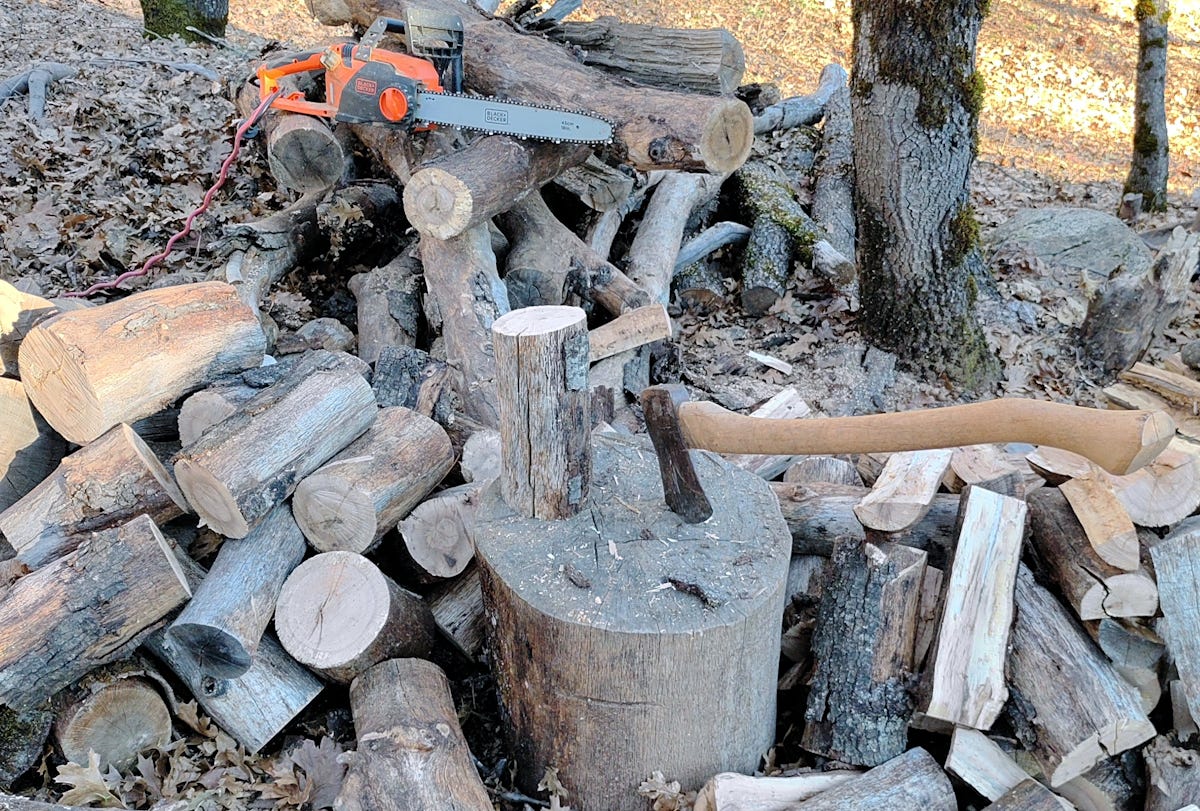(If you like this post, selecting the ❤️ to bless the Algorithm Angels.)
There’s a generous pile of rounds, logs, and branches (mostly black oak) sitting near our house, waiting for me to buck, split, and stack it so it can season during the heat of the summer and be ready for our wood stove the next winter. I gather this wood from the forest around the house, either from deadfall or from stems that need thinning, and I carry or drag the logs by hand to my processing area.
I have an electric chainsaw for bucking the wood into rounds, which I prefer over a gas-powered saw because it’s quieter and doesn’t leave me smelling like exhaust. Once the rounds are dry enough, I split them by hand with a maul or axe, occasionally employing a wedge or a hand-operated hydraulic splitter for the really stubborn ones (such as pieces of California live oak, a very dense wood that doesn’t split easily even after letting it sit for several years).
When I fell a tree, I like to use as much of it as I can, generally down to branches that are about an inch thick. Doing so provides me with smaller pieces of wood that I use when building fires in my wood stove. I even break up some of the smaller dead branches for kindling and collect branches and twigs that fall off the trees naturally (a talent that black oak has in abundance).
Why do I bother? Why do I spend so much time and effort in cutting my own wood instead of just buying pre-split wood? After all, given the time I spend, my labor here doesn’t save me more than perhaps $10/hour. And why don’t I employ more power tools, like a gas-powered splitter, to speed up the process?
Well, there are many reasons for my choice. For one thing, I enjoy the manual labor: it gets me outside and I find it much more interesting to swing a maul and move the wood around than to lift weights in a stuffy gym. I also find satisfaction in using the fuels that are right around the house; it’s a big reason why we installed a wood stove in the first place. I also think that the forest itself, at whatever level of consciousness it manifests, appreciates the degree to which I try to steward its resources.
Another satisfaction comes from exercising the necessary patience to wait until the rounds, especially the live oak, are ready to split by hand. One summer’s heat is enough for black oak but with the live oak I usually have to wait 3-4 years so that the exceptionally dense wood begins to decompose slightly (at which point there’s plenty of fuel value left).
Working the wood piles is also a bit of a welcome break from the usual patterns of modern life that are typically dominated by technology, in the same way that other people like to raise chickens, tend gardens, or engage in other forms of homesteading. And when I handle the wood again in the winter, it’s almost like greeting old friends, despite the fact that I’m going to shove them into an inferno to boil off and combust their stored hydrocarbons.1
In short, I find value in the process of putting up my firewood by hand, not just in having the final product. I like the experience that I gain in the process and also like the effects of that experience on body, mind, and soul.
Admittedly, though, I have the luxury of not depending on firewood for heat: our wood stove is secondary to our central propane heater. Were the wood stove my only source of heat, as it is for a number of my neighbors, or if I was physically incapable of doing the work, the calculus would change dramatically to favor production over process, experience, and effect.
In such circumstances I’d likely outsource the work and just buy seasoned wood from a professional. Or, if I still wanted to use the wood around the house, I’d optimize the process with a more powerful gasoline chainsaw and a powered splitter. And if woodcutting was the source of my livelihood, I’d most certainly use the best tools I could to automate and optimize my tasks.
And this is where my woodchopping intersects with the question of using the artificial intelligence (AI).
A side note: augmented vs. artificial intelligence
I would vastly prefer that “AI” stood for augmented intelligence rather than artificial intelligence, as the former implies a partnership whereas the latter implies a conflict. Back in 2019, in fact, when I was employed at Microsoft, I wrote an email to CEO Satya Nadella to make the case for using “augmented” instead of “artificial.” I was disappointed to never receive a reply, but we may get there by and by. A December 2024 article in the Wall Street Journal reported on research by an MIT graduate student demonstrating that AI enhances or amplifies—that is, augments—existing human skills rather than making up for a deficiency of those skills—that is, enabling less-skilled people to produce on the same level as a skilled person. If such a finding proves true in multiple areas of human endeavor, then we may reach the point where we remember that the “intelligence” in AI is and always has been human intelligence rather than the product of what is, in the end, blind computation on 0s and 1s.
If experience is the goal
As you’re undoubtedly aware, AI tools are imposing themselves upon mainstream life. The new Windows 11 laptop I acquired last November, for example, has a CoPilot key right on the keyboard (which I remapped to Ctrl). AI tools are integrated with many applications to the extent that they’re becoming intrusive, such as the insistent prompt offering to rewrite your words. And AI has been cropping up in places that seem entirely unnecessary, like AI-enabled bird-feeders (no joke; see mybirdbuddy.com).2
Consequently, people in many creative fields, such as fiction writing, are wondering if and how they might make use of those tools in a way that is yet psychologically and spiritually beneficial rather than deadening or dehumanizing. Such concerns are (or at least should be) especially present with spiritually-oriented writing that seeks to enliven the deepest essence of what it means to be human.
Ethical and philosophical issues aside (e.g. use of copyrighted material for training data), I know, for example, that I could use generative AI to write entire short stories or even novels given a suitably detailed prompt. I’d just need to do a little editing to touch up the details here and there. And if I depended on producing lots and lots of stories to earn my living, I’d very much consider that path.
But what if my goal isn’t actually production? As one Internet meme puts it, “I don’t want AI to do my writing so I have more time for cooking and laundry, I want AI to do my cooking and laundry so I have more time for writing!” Indeed, there are many activities that we do specifically for the experience: eating, travel, hiking, skiing, sex, reading, meditating…the list goes on. We’d really never expect or want a machine to try to do these things for us. The fact that many hardcore AI proponents are also staunch supporters of sending humans back to the moon and to Mars is a flat-out admission that a machine’s experience is simply not enough and could never substitute for human experience.
The precious experience of writing
Like my woodchopping, I think that one of the greatest benefits of writing, especially the spiritual, devotional, and mystical realism that we’re talking about here on Deus in Fabula, is the experience of the writing. Indeed, I consider it a privilege, as I wrote in the posts The privilege of writing inner experiences part 1 and part 2:
No art forms other than those built on the portrayal of characters in stories—that is, writing and acting—ask the artist, in every case, to deeply share the inner experience of another person, even if that other person is imagined.
And furthermore, where the consumers of such art are concerned:
…written fiction stands alone as the one form through which readers (and listeners with audiobooks) also get to share that inner experience of another. It’s a big reason why people read (or listen to) fiction in the first place.
As I also wrote in Inner experience: a unique value of written stories, readers get to spend extended time with a character’s inner experience: what might be five or six seconds in “story time,” as experienced by the character, might take something like a minute and a half to read. That’s a 15:1 time ratio, not including the time you might spend re-reading the passage. And writing such passages takes even longer: I gave an example in Privilege part 2 of a 500-word passage for two minutes of story time that took me nearly 50 times that long to write.
But again, instead of considering that extra time a burden, I consider it a blessing: spending an extended period of time immersed in a spiritually-oriented scene can be deeply uplifting. It’s a matter of decorating the soul, not just decorating the page.
Why, then, would I want to give that precious time away to a soulless computational engine?
(Warning: the image below came from Substack’s image generator using the prompt, “making a sacrifice at the altar of a computer.” The result is rather gruesome, but I think makes a fine point about the soulless nature of the technology.)
What’s more, I enjoy not just writing the stories, but writing them longhand (for which I use a Supernote A6X2 that makes it much easier to convert handwritten text into digital form than transcribing by hand). I write longhand because I find that my mind works in a different way than it does when typing, even for and perhaps especially with creative work. And as various studies indicate, writing by hand has various neurological benefits.3
A matter of priorities
My decision to not outsource the task of writing to AI is the same as with woodchopping: if my priority is the acquisition of the end product and not the experience, then using AI to “do” a lot of the writing work for me is an appropriate use of what is fundamentally an automation technology like a power tool.
In fact, I’m doing another project (unrelated to Deus in Fabula) that involves creating a simple web application with standard HTML markup, basic CSS styling, and fairly run-of-the-mill JavaScript code. I’ve enough general experience with web development to know what I’m doing with these technologies, but I lack expertise in a number of details.
For this one-off project, I’m primarily concerned with short-term productivity and not with deepening my software development skills (as I might be if I was thinking to restart my former tech career). Thus, an AI tool like Microsoft’s CoPilot is quite helpful: by clearly stating the type of code I need, it does a great job of assembling that code from all its training data—millions of lines of publicly-available code in which others have already solved the same problems.
That said, I still needed enough know-how to understand what the code was doing, how to test it properly, and how to modify it as needed and correct bugs. But the AI tool reduced the total amount of work by probably 75%. I didn’t learn as much in the process, but again, gaining experience wasn’t the point.
Coming in part 2
In the end, no matter what automation tools we’re talking about for whatever task, their availability simply provides the opportunity to ask ourselves what we want from the performance of the task in question. How much experience do we want, and how much productivity? I imagine we usually want some of both, so it’s never an either-or question. The blend might also vary even with similar tasks.
Personally, I know that because writing the kind of fiction that we’re discussing on Deus in Fabula is, for me, a spiritual practice, then there’s little point in outsourcing the process to a datacenter. If there comes a time, though, when production is my goal, then I’ll certainly consider how I might use AI tools. At the same time, as I’ll discuss in part 2, I’m not convinced that AI-generated text will have the unique richness and character that a human author brings to the table, which again makes the case for AI as augmented, rather than artificial, intelligence.
What are your thoughts on this matter?
(If you like this post, selecting the ❤️ to bless the Algorithm Angels.)
In case you’re wondering, which you probably aren’t, the fuel value of any given wood relates to its density of combustible hydrocarbons. Wood with high density, like madrone, is an excellent fuel; wood with low density, like ponderosa pine, isn’t worth the trouble to cut and split.
Burning wood is actually a process that starts with heating the wood enough to boil the hydrocarbons out of its cellulose structure, a process called pyrolysis. Once freed into gases at a suitable temperature, those hydrocarbons combust with available oxygen, meaning that they combine in a chemical reaction that releases energy in the form of heat and light and leaves behind the byproducts of carbon dioxide and water, among a few other things. Technically, only smoldering happens on the surface the wood itself; most of what we call burning happens away from the surface where the gases combine with oxygen. What doesn’t boil off or smolder, the “incombustible” material, is left behind as ash—I’m always fascinated to see ashen structures that retain the shape and patterns of the original wood. For a little more on this subject, see The Wood Distillation Experiment, which shows what happens when wood is heated in the absence of oxygen.
Here on Substack, too, I have the option to generate graphics whenever I want. For various reasons, such as copyright questions and the lack of consciousness in computationally-generated “art,” I hardly ever use that feature, and yet it’s always holding out the temptation to inject colorful eye-candy into a post with almost zero effort.
See, for example, Are we losing the ability to write by hand (The Guardian).








